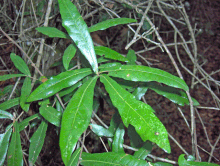Quercus hemisphaerica
| Quercus hemisphaerica | |
|---|---|

| |
| Scientific classification | |
| Kingdom: | Plantae |
| Clade: | Tracheophytes |
| Clade: | Angiosperms |
| Clade: | Eudicots |
| Clade: | Rosids |
| Order: | Fagales |
| Family: | Fagaceae |
| Genus: | Quercus |
| Subgenus: | Quercus subg. Quercus |
| Section: | Quercus sect. Lobatae
|
| Species: | Q. hemisphaerica
|
| Binomial name | |
| Quercus hemisphaerica | |

| |
| Synonyms[2] | |
|
List
| |
Quercus hemisphaerica (sand laurel oak, laurel oak, Darlington oak, laurel-leaf oak) is a species of
red oak section of Quercus sect. Lobatae. It is often confused with and closely related to Quercus laurifolia
(swamp laurel oak), from which it differs in several key characteristics.
Description
Quercus hemisphaerica is a medium-sized
elliptical or narrowly ovate, and 3–12 centimeters (1+1⁄8–4+3⁄4 inches) long by 1–4 cm (3⁄8–1+5⁄8 in) wide. The petiole is very short, ranging from 1–5 millimeters (1⁄16–3⁄16 in) long, and the leaf base is obtuse to rounded. The acorns are hemispheric in shape and 9 to 16.5 mm (3⁄8 to 5⁄8 in) by 9 to 16.5 mm (3⁄8 to 5⁄8 in). The acorns take 18 months to mature and are a fourth to a third covered by a saucer- to bowl-shaped cap.[3]
Similar species
Q. hemisphaerica resembles Quercus laurifolia (swamp laurel oak). They can be distinguished using these criteria.
- When both sand laurel oak and swamp laurel oak are growing in the same area, sand laurel oak will flower about two weeks later than swamp laurel oak.
- Sand laurel oak grows on dry sandy soils, while swamp laurel oak grows on flood plains, river bottoms, and occasionally poorly drained upland soils.
- Sand laurel oak has narrow ovate or elliptic leaves, while swamp laurel oak has rhombic or broad ovate leaves.
- Sand laurel oak has an cuneateor attenuate leaf base.
- Sand laurel oak is mostly evergreen, while swamp laurel oak is mostly tardily deciduous.
Distribution and habitat
The tree can be found from Texas to Delaware.[4]
It grows in somewhat
xeric
sandy soils, on sand hills, and sometimes on hillsides.
Ecology
There is at least one known hybrid involving Q. hemisphaerica which is with Q. laevis (Q. × mellichampii Trel.).
References
External links
- North Carolina State Fact Sheet: Laurel Oak
- Auburn University, Trees of Alabama and the Southeast: Laurel Oak
- Virginia Tech, Department of Forestry Fact Sheet: Darlington oak
- United States Department of Agriculture plants profile: Darlington oak
- Floridata: Quercus hemisphaerica
- Institute of Food and Agricultural Sciences, University of Florida: Laurel Oak or Swamp Laurel Oak?

